The NVIDIA GeForce GTX 980 Ti Review
by Ryan Smith on May 31, 2015 6:00 PM ESTPower, Temperature, & Noise
As always, last but not least is our look at power, temperature, and noise. Next to price and performance of course, these are some of the most important aspects of a GPU, due in large part to the impact of noise. All things considered, a loud card is undesirable unless there’s a sufficiently good reason – or sufficiently good performance – to ignore the noise.
As the GM200 flagship card, GTX Titan X gets the pick of the litter as far as GM200 GPUs go. GTX Titan X needed fully-functional GM200 GPUs, and even then needed GPUs that were good enough to meet NVIDIA’s power requirements. GTX 980 Ti on the other hand, as a cut-down/salvage card, gets second pick. So we expect to see these chips be just a bit worse; to have either functional units that came out of the fab damaged, or have functional units that have been turned off due to power reasons.
| GeForce GTX Titan X/980 Voltages | ||||
| GTX Titan X Boost Voltage | GTX 980 Ti Boost Voltage | GTX 980 Boost Voltage | ||
| 1.162v | 1.187v | 1.225v | ||
Looking at voltages, we can see just that in our samples. GTX 980 Ti has a slightly higher boost voltage – 1.187v – than our GTX Titan X. NVIDIA sometimes bins their second-tier cards for lower voltage, but this isn’t something we’re seeing here. Nor is there necessarily a need to bin in such a manner since the 250W TDP is unchanged from GTX Titan X.
| GeForce GTX 980 Ti Average Clockspeeds | |||
| Game | GTX 980 Ti | GTX Titan X | |
| Max Boost Clock | 1202MHz | 1215MHz | |
| Battlefield 4 |
1139MHz
|
1088MHz
|
|
| Crysis 3 |
1177MHz
|
1113MHz
|
|
| Mordor |
1151MHz
|
1126MHz
|
|
| Civilization: BE |
1101MHz
|
1088MHz
|
|
| Dragon Age |
1189MHz
|
1189MHz
|
|
| Talos Principle |
1177MHz
|
1126MHz
|
|
| Far Cry 4 |
1139MHz
|
1101MHz
|
|
| Total War: Attila |
1139MHz
|
1088MHz
|
|
| GRID Autosport |
1164MHz
|
1151MHz
|
|
| Grand Theft Auto V |
1189MHz
|
1189MHz
|
|
The far more interesting story here is GTX 980 Ti’s clockspeeds. As we have pointed out time and time again, GTX 980 Ti’s gaming performance trails GTX Titan X by just a few percent, this despite the fact that GTX 980 Ti is down by 2 SMMs and is clocked identically. On paper there is a 9% performance difference that in the real world we’re not seeing. So what’s going on?
The answer to that is that what GTX 980 Ti lacks in SMMs it’s making up in clockspeeds. The card’s average clockspeeds are frequently two or more bins ahead of GTX Titan X, topping out at a 64MHz advantage under Crysis 3. All of this comes despite the fact that GTX 980 Ti has a lower maximum boost clock than GTX Titan X, topping out one bin lower at 1202MHz to GTX Titan X’s 1215MHz.
Ultimately the higher clockspeeds are a result of the increased power and thermal headroom the GTX 980 Ti picks up from halving the number of VRAM chips along with disabling two SMMs. With those components no longer consuming power or generating heat, and yet the TDP staying at 250W, GTX 980 Ti can spend its power savings to boost just a bit higher. This in turn compresses the performance gap between the two cards (despite what the specs say), which coupled with the fact that performance doesn't scale lineraly with SMM count or clockspeed (you rarely lose the full theoretical performance amount when shedding frequency or functional units) leads to the GTX 980 Ti trailing the GTX Titan X by an average of just 3%.
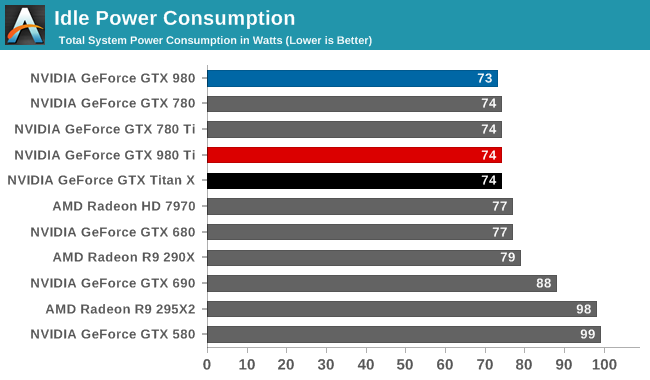
Starting off with idle power consumption, there's nothing new to report here. GTX 980 Ti performs just like the GTX Titan X, which at 74W is second only to the GTX 980 by a single watt.
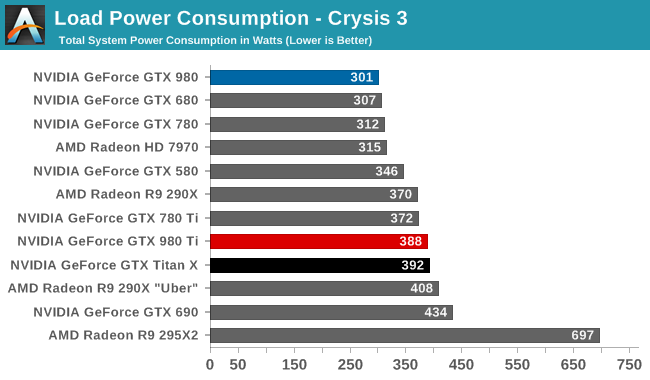
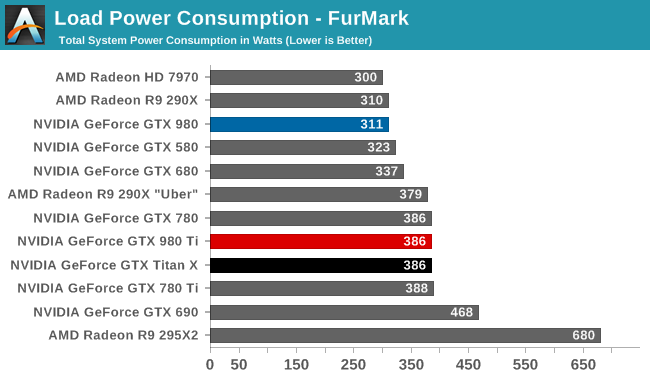
Meanwhile load power consumption is also practically identical to the GTX Titan X. With the same GPU on the same board operating at the same TDP, GTX 980 Ti ends up right where we expect it, next to GTX Titan X. GTX Titan X did very well as far as energy efficiency is concerned – setting a new bar for 250W cards – and GTX 980 Ti in turn does just as well.
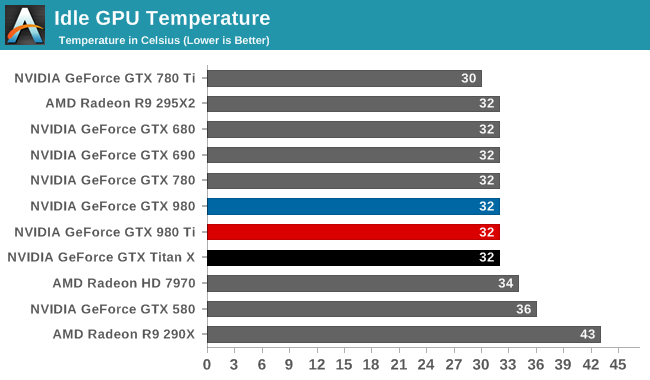
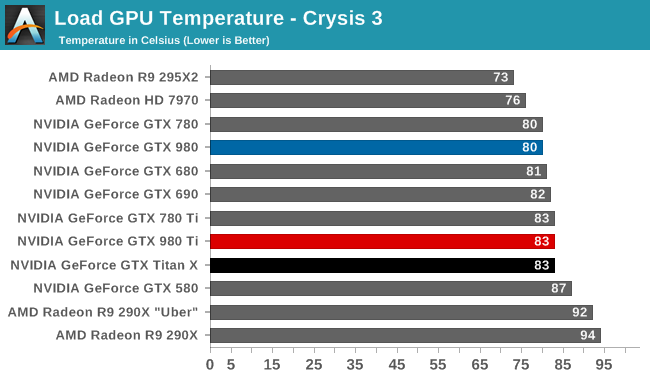
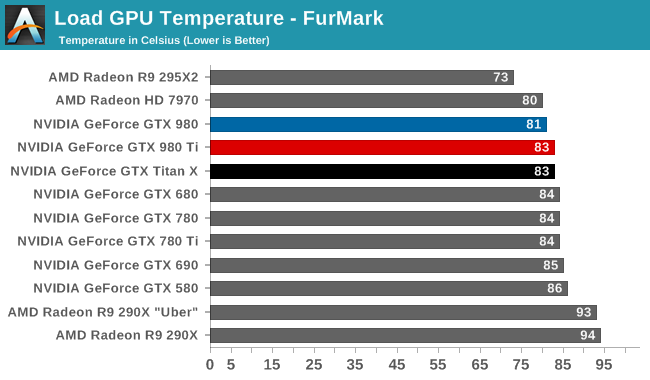
As was the case with power consumption, video card temperatures are similarly unchanged. NVIDIA’s metal cooler does a great job here, keeping temperatures low at idle while NVIDIA’s GPU Boost mechanism keeps temperatures from exceeding 83C under full load.
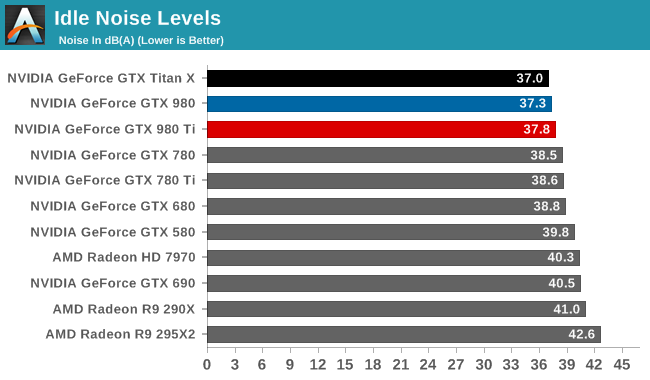
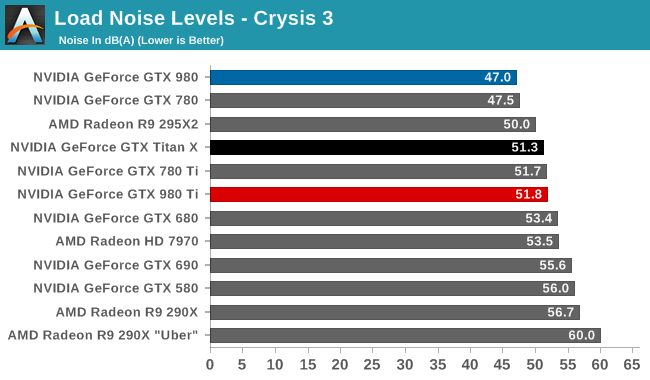
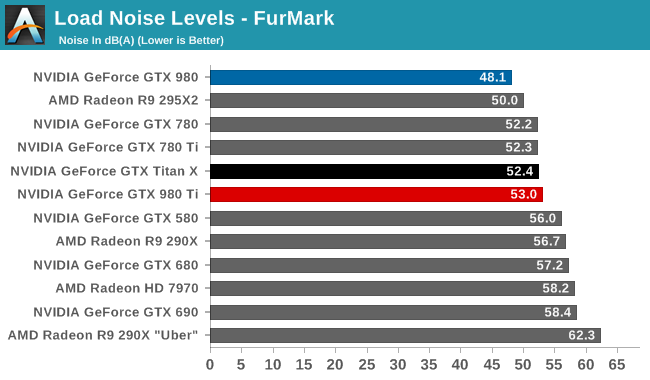
Finally for noise, the situation is much the same. Unexpected but not all that surprising, the GTX 980 Ti ends up doing a hair worse than the GTX Titan X here. NVIDIA has not changed the fan curves or TDP, so this ultimately comes down to manufacturing variability in NVIDIA’s metal cooler, with our GTX 980 Ti faring ever so slightly worse than the Titan. Which is to say that it's still right at the sweet spot for noise versus power consumption, dissipating 250W at no more than 53dB, and once again proving the mettle of NVIDIA's metal cooler.










290 Comments
View All Comments
Casecutter - Tuesday, June 2, 2015 - link
Nvidia places the TitanX in play just so that logic works... But when you pull TitanX from the equation, and work from the 980 (GM204) a 20% increase in FpS for, almost 20% more money, and use 28% more power. It look really humdrum.Kutark - Wednesday, June 3, 2015 - link
You felt the need to post basically the same comment in 2 different places?Regardless you're cherry picking data. Overall its about a 30% increase in perf, for about a 30% increase in price. Its still a "good" deal if you want a powerful single GPU.
uglyduckling81 - Tuesday, June 2, 2015 - link
I'm still shocked at how much the 295x2 kills it. It's so much more powerful that even a Titan X. Newegg had the 295x2 on a sale for $550 2 weekends ago as well. Crossfire driver issues aside if your in the market for the high end I just don't see how you could go past the much more powerful and cheaper 295x2. If I had been in the USA with that $550 sale going I would of snapped that up so fast. Hell I would of bought several and sold a couple when I got home. Those cards are still $1600 in Australia.mapesdhs - Wednesday, June 3, 2015 - link
Really? CF issues aside?? It's a freakin' CF card! What the heck is the point in buying the thing if CF support just doesn't work properly for so many games? And did AMD ever fix DX9/CF issues? Still sucks the last time I tested 7970 CF. Feel free to whack your power bill with the 295x2, spew out heat, etc. Every time I see a crazy extended power usage graph just so the enormous line for the 295x2 can be included, it blows my mind that people ever bother buying it. One person from OZ here commented that heat output is of primary concern where he lives, so chucking out so much heat from a 295x2 would be a real problem. I noticed the same thing with 580 SLI, sooo glad I eventually switched to a single 980.CiccioB - Thursday, June 4, 2015 - link
The fact that a supposedly more powerful card is sold at a lower price should automatically raise you some questions... it is not that because 290x2 is a single card that all crossfire problems magically go away.Drive issue apart is not an option. Crossfire and SLI performances depend heavily on driver quality. And, sorry, but AMD dual GPUs cards have always been the worst choice since they were created.
See what is the support for 7990 cards. 690 cards are still supported as you can see in these very benchmarks.
Moreover, if you want a better dual configuration with support done as one would expect for the spent money, you can just buy 2x GTX970 and live much more happily. Consuming much more less. Dual GPU comparison here is not even to take into account. The simplicity, scaling and smoothness of a single GPU like Titan X or this GTX980TI simply crush the dual GPU competition without any doubt, even though they do some FPS less as average.
If you cannot understand that, it is right that you continue buying crappy cards and be happy with those.
NvidiaWins - Wednesday, June 3, 2015 - link
Compared to my Evga 770 SuperClocked Sli, it only generates a few extra fps, scored just over 100 points higher in Firestrike(770 Sli graphic score- 16,837/ 980Ti graphic score- 16,900), its a great single card at a cheap price point, but little improvement over what I currently use.Zak - Saturday, June 13, 2015 - link
Compare your dual 770 against dual 980ti and then we'll talk...godrilla - Thursday, June 4, 2015 - link
It seems that nvidia created the titan x just to make the 980ti seem like a bargain so that gamers will jump at it pretty clever.nadia28 - Thursday, June 18, 2015 - link
Yeah, that what I thought too. They keep thinking of new marketing strategies to boost the sales and this one works like a charm.CHRAHL - Saturday, June 6, 2015 - link
Ryan! We never saw a review from GTX 960, will it be published. And there is no data in bench from it hence. Could you at least upload performance to bench section..